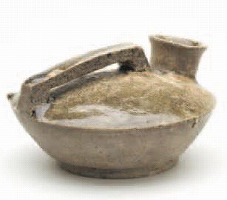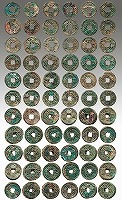
NABUNKEN NEWS vol.48
Report of buried objects for purification rite unearthed at the Sakata-dera temple site
The SK160 earth pit found through the 5th investigation is located north-east of the SB150, the pivotal building among all structures of the temple complex in the Sakata-dera temple site including halls, towers, etc., constructed in the late 8th century. This earth pit may be a feature of the groundbreaking ritual equipment used for the structural platform, which dates back to the latter half of the 8th century and was flattened over subsequent periods of time. From SK160, a variety of earthenware and other artifacts have been unearthed, such as Hajiki-ware (plain, unglazed, or reddish-brown pottery), Sueki-ware (blue-gray ancient high-fired pottery), etc., as well as bowls made of "Sahari" (copper alloy with traces of silver, lead, or tin), copper coins, copper bells, metal ware including gold foil, etc., and amber/glass beads.
Unearthed copper coins total 291 pieces comprised of the three types of ancient coins (Wado-kaichin, Mannen-tsuho, and Jingu-kaiho), as well as Kaigen-tsuho of the Tang dynasty. Meanwhile, we have found that some coins have fibrous traces possibly resulting from a plant, as well as traces of twined string. When the coins were excavated, they were found lying in apparent bunches within the pit. Therefore, it is possible that in some spots, the coins were buried in the form of Sashizeni, coins bundled using string. In addition, some other coins had the residue of a plain-woven fiber, possibly indicating that those coins were packed with cloth and that there were other ways to bury them other than as Sashizeni, bundled coins.
All the earthenware is small. The Sueki-ware shown in the photo is referred to as "Hiraka" (flattened bottle). Considering the natural glaze on the outer surface as well as shape, method of manufacture, etc., the Sueki-ware may be a product of Sanageyo (lit. Sanage kilns), which was located in what is now Aichi prefecture.
The Darani-jikkyo, a sutra imported from Tang, China in the early Nara period, prescribes the ritual to bury the seven treasures (gold, silver, pearls, coral, amber, crystal and lapis lazuli) and five grains (barley, wheat, rice, red beans and sesame) in the base platform when constructing a Buddhist temple. Furthermore, as gold foil, amber and glass beads additionally excavated from the SK160, it is possible that the groundbreaking ritual of these structural remains is based on the ritual prescribed in the Darani-jikkyo sutra.
(KIMURA Rie, Department of Imperial Palace Sites Investigations)
 |
 |
